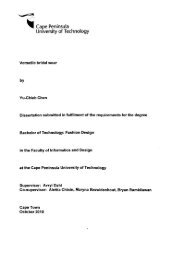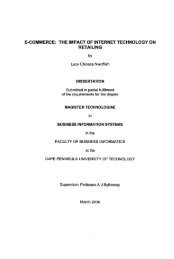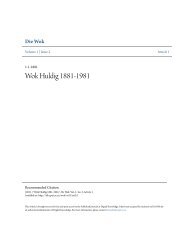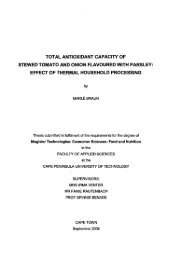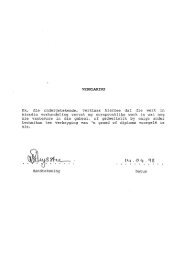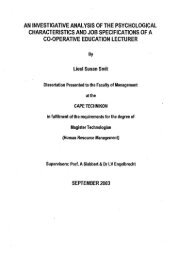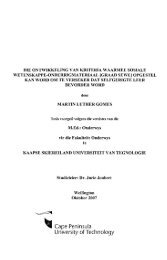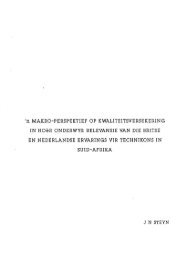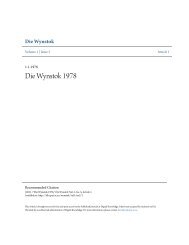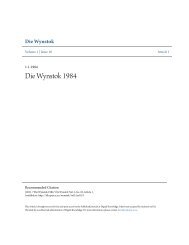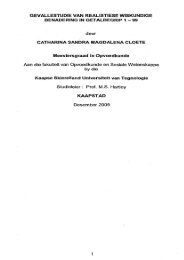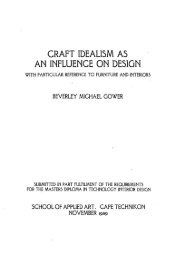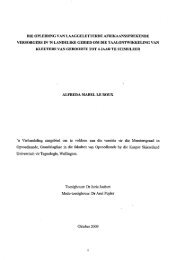the effect of the particle size distribution on non-newtonian turbulent ...
the effect of the particle size distribution on non-newtonian turbulent ...
the effect of the particle size distribution on non-newtonian turbulent ...
You also want an ePaper? Increase the reach of your titles
YUMPU automatically turns print PDFs into web optimized ePapers that Google loves.
Appendix B C<strong>on</strong>ference Paper<br />
ABSTRACT<br />
PARTICLE ROUGHNESS<br />
TURBULENCE<br />
PT SLATTER, G S THORVALDSEN & F W PETERSEN<br />
Cape Technik<strong>on</strong>, Cape Town, South Africa<br />
The <strong>turbulent</strong> flow <str<strong>on</strong>g>of</str<strong>on</strong>g>n<strong>on</strong>-Newt<strong>on</strong>ian slurries has remained a problem, despite much<br />
research in this area. The successful resoluti<strong>on</strong> <str<strong>on</strong>g>of</str<strong>on</strong>g>this problem is vitally imp<strong>on</strong>anr not<br />
<strong>on</strong>ly for hydrotransp<strong>on</strong> applicati<strong>on</strong>s involving fine slurries, but also for mixed regime<br />
slurries, where <str<strong>on</strong>g>the</str<strong>on</strong>g> vehicle comp<strong>on</strong>ent is usually a n<strong>on</strong>-Newt<strong>on</strong>ian slurry. Two major<br />
problem areas are that <str<strong>on</strong>g>the</str<strong>on</strong>g> <strong>turbulent</strong> behaviour <str<strong>on</strong>g>of</str<strong>on</strong>g><str<strong>on</strong>g>the</str<strong>on</strong>g>se slurries appears unrelated to<br />
<str<strong>on</strong>g>the</str<strong>on</strong>g>ir laminar behaviour and yet has been found to be strikingly similar to Newt<strong>on</strong>ian<br />
<strong>turbulent</strong> behaviour, in spite <str<strong>on</strong>g>of</str<strong>on</strong>g><str<strong>on</strong>g>the</str<strong>on</strong>g> obvious difference in rheology.<br />
This paper explores <str<strong>on</strong>g>the</str<strong>on</strong>g>se and o<str<strong>on</strong>g>the</str<strong>on</strong>g>r problem areas in <str<strong>on</strong>g>the</str<strong>on</strong>g> literature and shows how<br />
previous <str<strong>on</strong>g>the</str<strong>on</strong>g>oretical models havefailed to address <str<strong>on</strong>g>the</str<strong>on</strong>g>m adequately. A new approach to<br />
turbulence modelling is reviewed which does address <str<strong>on</strong>g>the</str<strong>on</strong>g>se problem areas. This approach<br />
is based <strong>on</strong> <str<strong>on</strong>g>the</str<strong>on</strong>g> panicle roughness <str<strong>on</strong>g>effect</str<strong>on</strong>g>, but is as yet relatively untested outside <str<strong>on</strong>g>the</str<strong>on</strong>g><br />
range ojslurries and panicle <str<strong>on</strong>g>size</str<strong>on</strong>g>s <strong>on</strong> which it was originally evaluated.<br />
An experimentalprogramme has been initiated to investigate and accumulate a data base<br />
<str<strong>on</strong>g>of</str<strong>on</strong>g><str<strong>on</strong>g>the</str<strong>on</strong>g> behaviour <str<strong>on</strong>g>of</str<strong>on</strong>g>a wider range <str<strong>on</strong>g>of</str<strong>on</strong>g>n<strong>on</strong>-Newt<strong>on</strong>ian slurries. including slurries with a<br />
bimodal panicle <str<strong>on</strong>g>size</str<strong>on</strong>g> <str<strong>on</strong>g>distributi<strong>on</strong></str<strong>on</strong>g>. These new data are analysed and <str<strong>on</strong>g>the</str<strong>on</strong>g> results are<br />
presented and discussed. It is c<strong>on</strong>cluded that <str<strong>on</strong>g>the</str<strong>on</strong>g> new approach to turbulence modelling<br />
using <str<strong>on</strong>g>the</str<strong>on</strong>g> panicle roughness <str<strong>on</strong>g>effect</str<strong>on</strong>g> is valid for <str<strong>on</strong>g>the</str<strong>on</strong>g> slurries tested.<br />
1. INTRODUCTION<br />
The predicti<strong>on</strong> <str<strong>on</strong>g>of</str<strong>on</strong>g><strong>turbulent</strong> flow or pipe flow energy requirements from <strong>on</strong>ly <str<strong>on</strong>g>the</str<strong>on</strong>g> viscous<br />
properties <str<strong>on</strong>g>of</str<strong>on</strong>g> n<strong>on</strong>-Newt<strong>on</strong>ian suspensi<strong>on</strong>s has over <str<strong>on</strong>g>the</str<strong>on</strong>g> years been questi<strong>on</strong>ed by<br />
researchers. It has been found that <str<strong>on</strong>g>the</str<strong>on</strong>g> flow behaviour and rheology <str<strong>on</strong>g>of</str<strong>on</strong>g><str<strong>on</strong>g>the</str<strong>on</strong>g>se suspensi<strong>on</strong>s<br />
is influenced by such factors as <str<strong>on</strong>g>particle</str<strong>on</strong>g> <str<strong>on</strong>g>size</str<strong>on</strong>g>, shape, weight and <str<strong>on</strong>g>distributi<strong>on</strong></str<strong>on</strong>g> (philipp<str<strong>on</strong>g>of</str<strong>on</strong>g>f<br />
1944, Hedstrom 1952, Orr & Blocker 1955, Zettlemoyer & Lower 1955, Maude &<br />
Whitmore 1956, Thomas 1963, Thomas 1983, Mun 1988, Slatter 1994).<br />
The <strong>turbulent</strong> flow <str<strong>on</strong>g>of</str<strong>on</strong>g> n<strong>on</strong>-Newt<strong>on</strong>ian suspensi<strong>on</strong>s is complex and is <str<strong>on</strong>g>of</str<strong>on</strong>g>ten c<strong>on</strong>sidered<br />
problematic to design. However, in many situati<strong>on</strong>s it has beneficial characteristics,<br />
B.2



